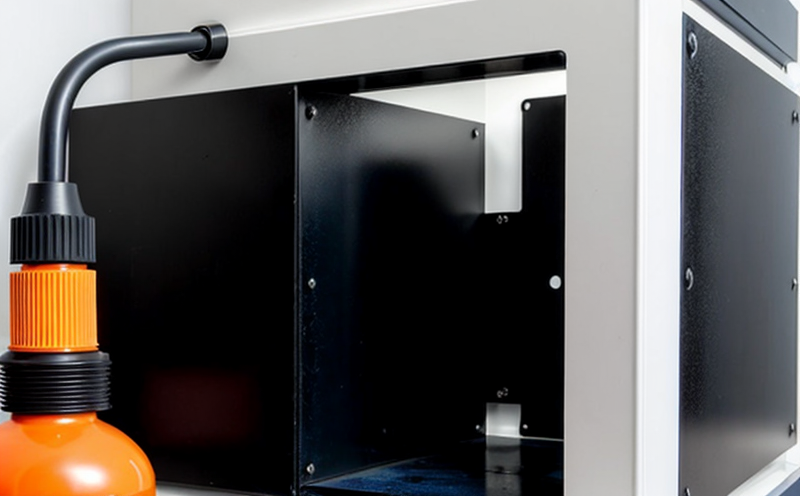ASTM D4587 UV Exposure Testing of Coated Materials
The ASTM D4587 standard provides a method for evaluating the resistance to ultraviolet (UV) radiation of coated materials used in various industries, including automotive, aerospace, and construction. This testing is crucial for ensuring that coatings remain stable under prolonged exposure to sunlight, which can lead to degradation over time.
The process involves exposing coated specimens to UV radiation using a xenon-arc lamp with a filtered broadband spectrum similar to natural sunlight. The specimens are subjected to specific conditions of temperature and humidity to simulate real-world environmental stresses. After the prescribed period, the samples undergo visual inspection for color change, gloss loss, and other signs of degradation.
Specimen preparation is critical in ASTM D4587 testing. Samples must be cut into standard sizes (typically 100 mm x 25 mm) to ensure consistent exposure across all specimens. The coated side should face the lamp during exposure. After exposure, samples are visually inspected for changes in appearance and adhesion tests are performed.
The methodology outlined by ASTM D4587 ensures accurate and reproducible results that can be used to compare different coatings or to monitor changes over time. Compliance with this standard is essential for quality managers and compliance officers looking to ensure their products meet international standards. For R&D engineers, this testing provides critical data on the durability of new formulations.
For procurement professionals, ASTM D4587 UV exposure testing ensures that materials purchased will perform reliably in end-use environments. This service is particularly important for industries where coatings are exposed to high levels of sunlight, such as architectural paints and automotive finishes.
The test results from ASTM D4587 can help predict the lifespan of coated products under real-world conditions. By understanding how UV radiation affects these materials, manufacturers can optimize their product design and formulation processes to enhance longevity and performance.
Understanding the process is essential for those involved in quality assurance and compliance within industries that rely heavily on durable coatings. The testing ensures that all products meet or exceed specified standards, thereby maintaining high-quality standards across production lines.
Scope and Methodology
The scope of ASTM D4587 UV exposure testing is to evaluate the resistance of coated materials to ultraviolet radiation. This standard provides a detailed procedure for exposing specimens under controlled conditions that simulate real-world sunlight exposure.
- Specimens are exposed to xenon-arc lamps with filtered broadband spectra.
- The test can be conducted at various temperature and humidity levels depending on the intended use of the material.
- Visual inspection is performed after a specified period to assess changes in appearance such as color fading or gloss loss.
- Adhesion tests are conducted to determine how well the coating adheres to the substrate.
The methodology ensures that all tests follow consistent procedures, which helps in achieving reliable and reproducible results. This is particularly important for industries where product durability is critical, such as coatings used in outdoor applications or those exposed to harsh environmental conditions.
For quality managers and compliance officers, understanding the scope of ASTM D4587 allows them to ensure that all tests are conducted according to international standards. For R&D engineers, this knowledge helps in developing coatings that can withstand UV radiation effectively. Procurement professionals benefit from this service as it ensures that materials purchased meet stringent durability requirements.
The detailed procedures outlined by ASTM D4587 provide a framework for conducting accurate and precise tests. By adhering to these standards, manufacturers can ensure their products are reliable and perform well under real-world conditions.
Industry Applications
- Automotive Industry: Ensuring that paint finishes on vehicles remain vibrant and durable over time.
- Aerospace Industry: Guaranteeing that coatings used in aircraft exteriors can withstand high UV exposure without degradation.
- BUILDING AND CONSTRUCTION: Verifying the longevity of architectural paints exposed to direct sunlight.
- MARINE INDUSTRY: Testing coatings on ships and marine structures for their resistance to UV radiation in salty environments.
In each application, ASTM D4587 provides a standardized approach to evaluating how UV exposure impacts coated materials. This ensures that all products undergo consistent testing, leading to more reliable outcomes across various industries.
For quality managers and compliance officers within these sectors, the results from ASTM D4587 tests are invaluable in maintaining high standards of product quality and ensuring regulatory compliance. For R&D engineers, this service offers critical insights into optimizing coating formulations for better UV resistance. Procurement professionals benefit by selecting materials that have been rigorously tested to ensure durability under real-world conditions.
Eurolab Advantages
At Eurolab, we offer comprehensive ASTM D4587 UV exposure testing services tailored to meet the specific needs of our clients. Our state-of-the-art facilities provide a controlled environment where specimens can be exposed to precise UV radiation conditions that mimic real-world sunlight.
The experienced team at Eurolab ensures that all tests are conducted according to international standards, ensuring accurate and reliable results. We use high-quality equipment and materials, which guarantees the precision of our testing process.
Our clients benefit from the expertise and experience of our staff who have extensive knowledge in material science and coating technologies. This allows us to provide insights that go beyond mere compliance with standards. We work closely with our clients to understand their unique requirements and develop customized testing protocols if necessary.
The use of advanced technology ensures that we can simulate a wide range of environmental conditions, including different temperatures and humidity levels. This versatility enables us to test materials under various simulated conditions, providing valuable data for product development and quality assurance.
Our commitment to excellence is reflected in the accuracy and reliability of our testing results. Clients receive detailed reports that include not only visual observations but also quantitative measurements such as color change values, gloss loss percentages, and adhesion strength figures.





